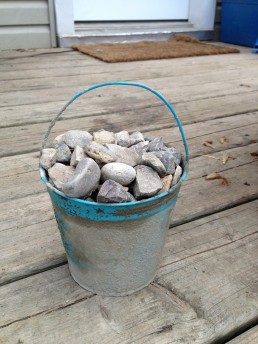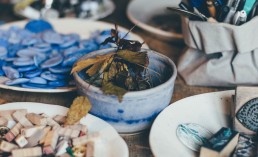Stone Trajectory
Throwing stones can be a great learning experience but remember to always make sure you have enough space around you so you don’t hit anyone or anything else!
Implementation
Place a bucket a short distance away from you and see if you can gently throw the stone underhand into the bucket. If this becomes easy for you then start to move the bucket a little further away. You can count how many stones you get into the bucket or you could number the stones and throw them in in order. As an extension you could have two buckets and share the stones equally between them.
 Intent- Learning Goals
Intent- Learning Goals
Trajectory Schema is an interest in lines and movement. This is a nice way to say your child keeps throwing things around the room or repeatedly dropping food from their highchair. Small babies begin to work on this schema when they track movement with their eyes and reach in front of them to grasp objects. They soon move on to dropping and posting items as they discover the world around them and how they can influence it. Toddlers exploring this path of development will favour activities that involve throwing objects
A great way to support this schema is to set up opportunities for posting and throwing.
- Cut holes in a cardboard box and let your little one post balls and toys into the holes.
- Set up different sized cardboard tubes for your child to post pompoms or cotton balls into.
- Give your child a variety of different object to throw or drop from a height and listen to the sounds they make when they land.
- Make ‘targets’ by drawing out circles on the ground outdoors or using buckets. Allow your child to throw toys, balls or even stones to hit the targets. This is a great exercise to work on their gross motor skills and get some of the throwing urges out of their system. Just make sure you move any breakables!
Physical Development – Moving and Handling
- Talk with children about the need to match their actions to the space they are in.
- Show children how to collaborate in throwing, rolling, fetching and receiving games
- Explain why safety is an important factor in handling tools, equipment and materials, and have sensible rules for everybody to follow.
22-36 months
- May be beginning to show preference for dominant hand.
40-60 months
- Shows increasing control over an object in pushing, patting, throwing, catching or kicking it.
Maths - Numbers
30-50 months
- Uses some number names accurately in play.
- Recites numbers in order to 10.
- Knows that numbers identify how many objects are in a set.
- Compares two groups of objects, saying when they have the same number.
40-60 months
- Recognises numerals 1 to 5+
- Counts objects to 10, and beginning to count beyond 10.
Impact
How did this activity go? Please use this space to record any findings, adaptions, reflections and quotes from your children. We would love you to email them back to us or share them on Tapestry, Instagram or Facebook.
Reggio Emilia At Home
Dear Parents, this is the first of many posts aimed to help those of you who are at home with your children. We will be providing daily activities for you to do with your children at home, and we would love to hear back from you every step of the way. Keep checking our Facebook posts and our Instagram stories for updates and share your findings on tapestry.
Overview of Reggio Emilia
One type of learning that many parents have adapted for use in the home-school setting is the Reggio Emilia approach. The Reggio Emilia approach to early childhood is a long used and well-respected technique used by educators and parents around the world. Reggio Emilia is a method, which requires no special training, just an understanding of basic principles.
In a nutshell, there are a few ideals that guide Reggio classrooms, and these can be easily transferred into the home setting. This philosophy was first developed in the 1960’s in Reggio Emilia, Italy, as a means to create an atmosphere to truly develop children’s intelligence and desire to learn. In this approach children were seen as highly capable, curious leaners, who are capable of constructing their own learning.
Reggio Materials
Open-ended items from nature play an important role in the Reggio inspired classroom. Pinecones, stones, shells, sticks, bark and leaves can be used for many purposes. Children can create from them, examine them, and use them to represent concepts. To have a large amount of stones for example will encourage maths, counting, making shapes, building, imagination and communication. The use of loose parts will keep your children occupied, investigating and using their imagination and problem solving ideas.

Other open-ended types of materials may include a collection of wooden blocks, scraps of fabric, a basket of scarves, ceramic tiles or mosaic glass pieces, cardboard tubes, or any other type of material that children may be interested in. You may be very interested to watch what children will create with everyday items
Activity One
Scavenger Hunt- One of the first things you could do with your children is to go on a resources hunt in the garden, attic or garage for any of the items above. We look forward to seeing your findings on tapestry, and remember almost anything can be classed as a loose part.
Principles of Reggio Emilia
This approach works on a few guiding principles, and parents who are seeking to implement a Reggio inspired home-school can use these as a guideline for their ‘classroom’.
- The child should have some control over their own learning. They should be allowed to develop and follow their own interests.
- Learning is best acquired through a multi sensory approach. Touching, listening, seeing, hearing and moving allow children to thoroughly understand.
- Teachers/parents are mentors and guides, but not the keepers of all knowledge. They should work alongside the children to ensure true understanding, but keep in mind that the learning process should be primarily child led.
- The environment is seen as the ‘third teacher’. Materials are carefully selected and rooms are free of clutter. Natural light, order and beauty are hallmarks of a Reggio classroom.
- Project based learning is encouraged. Instead of isolating subject areas, students are encouraged to truly research their interests from many angles. Whatever they choose to learn about can be read about, written about, painted, built etc.
- Documentation is paramount. One highlight of the Reggio approach is the importance it places of documentation. Examples of student work are highly visible. Teachers record children’s thoughts and conversations to then showcase them to make their thinking visible.
- Communication is imperative. In the Reggio approach, children are talked with, listened to, and respected. They are encouraged to use language to explore, and in the early years, sounds rhyme and rhythm are toyed with. Later, rich conversations drive much of a child’s learning.
- The One Hundred Languages of Children: One of the most important ideals driving the Reggio Emilia philosophy is referred to as the Hundred Languages of Learning. This means that children have many different ways to express their thoughts and learning. Hands- on learning and play are ways that children can demonstrate their learning, along with song, dance, drawing, writing, painting, physical activity, pretend play and story telling, just to name a few. Each of these activities are seen as valid methods of learning about the world and work together to compose an entire child.
Mirrors
 One hallmark to the Reggio approach is the use of mirrors throughout the play/work area. Mirrors are used not only on the walls, but also on surfaces to provide another point of view and depth of understanding. Children who are building with blocks can see their structure from a new perspective when a mirror is placed next to it. Children working with stones can see it from all angles when working on a mirrored surface. Using mirrors adds a new depth to children’s inquiry. When selecting mirrors for your home-school, you should keep the child’s age in mind. Very young children may need to use acrylic mirrors as a safety precaution as they may lean on them during their play, causing breakage.
One hallmark to the Reggio approach is the use of mirrors throughout the play/work area. Mirrors are used not only on the walls, but also on surfaces to provide another point of view and depth of understanding. Children who are building with blocks can see their structure from a new perspective when a mirror is placed next to it. Children working with stones can see it from all angles when working on a mirrored surface. Using mirrors adds a new depth to children’s inquiry. When selecting mirrors for your home-school, you should keep the child’s age in mind. Very young children may need to use acrylic mirrors as a safety precaution as they may lean on them during their play, causing breakage.
Inquiry Based learning
One of the best ways to determine ideas for study is by listening to the questions your children ask, or observing them while they are playing. Perhaps they said “It is so cool that water turns into the shape of my bucket when I pour it”, or “why don’t you ever see bats in the daytime?”. These simple conversations can lead to some of the best lessons you can do with your child. Stock your work area up with books about matter or nocturnal animals. Follow your child’s lead.
Once you have stumbled upon a topic that seems to grab your child’s attention, look for ways for them to explore it. Provide them with materials that can deepen their understanding and allow them to express themselves in one of the one hundred ways.
 The number one most important thing a home-school parent needs to remember is to follow the child. If they are not interested, they will not be engaged and very little true learning will occur. Often time, parents will see an activity that they think looks interesting or a book that they find beautiful only to be disappointed in their child’s lack of curiosity in the topic.
The number one most important thing a home-school parent needs to remember is to follow the child. If they are not interested, they will not be engaged and very little true learning will occur. Often time, parents will see an activity that they think looks interesting or a book that they find beautiful only to be disappointed in their child’s lack of curiosity in the topic.
Reggio Emilia is one great philosophy to adapt to a home-school setting. It is not expensive to implement, requires no specialised training, and is very flexible. Remembering a few simple principles will allow you to follow the lead of your child, and maximise their academic potential as well as foster a curious nature and a love of learning.
The Inspirations Home School Team

